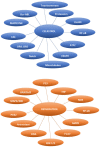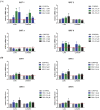Celastrol and Resveratrol Modulate SIRT Genes Expression and Exert Anticancer Activity in Colon Cancer Cells and Cancer Stem-like Cells
- PMID: 35326523
- PMCID: PMC8945991
- DOI: 10.3390/cancers14061372
Celastrol and Resveratrol Modulate SIRT Genes Expression and Exert Anticancer Activity in Colon Cancer Cells and Cancer Stem-like Cells
Abstract
Metastatic colorectal cancer (CRC) remains a hard-to-cure neoplasm worldwide. Its curability declines with successive lines of treatment due to the development of various cancer resistance mechanisms and the presence of colorectal cancer stem cells (CSCs). Celastrol and resveratrol are very promising phytochemicals for colon cancer therapy, owing to their pleiotropic activity that enables them to interact with various biological targets. In the present study, the anticancer activities of both compounds were investigated in metastatic colon cancer cells (LoVo cells) and cancer stem-like cells (LoVo/DX). We showed that celastrol is a very potent anti-tumor compound against metastatic colon cancer, capable of attenuating CSC-like cells at the molecular and cellular levels. In contrast, resveratrol has a much greater effect on colon cancer cells that are expressing standard sensitivity to anticancer drugs, than on CSC-like cells. In addition, both polyphenols have different influences on the expression of SIRT genes, which seems to be at least partly related to their anti-tumor activity.
Keywords: cancer stem cells; celastrol; colon cancer; resveratrol; sirtuins.
Conflict of interest statement
The authors declare no conflict of interest.
Figures










Similar articles
-
Genotoxic and Anti-Migratory Effects of Camptothecin Combined with Celastrol or Resveratrol in Metastatic and Stem-like Cells of Colon Cancer.Cancers (Basel). 2024 Sep 26;16(19):3279. doi: 10.3390/cancers16193279. Cancers (Basel). 2024. PMID: 39409900 Free PMC article.
-
Combination of Irinotecan and Melatonin with the Natural Compounds Wogonin and Celastrol for Colon Cancer Treatment.Int J Mol Sci. 2023 May 31;24(11):9544. doi: 10.3390/ijms24119544. Int J Mol Sci. 2023. PMID: 37298495 Free PMC article.
-
Prooxidative Activity of Celastrol Induces Apoptosis, DNA Damage, and Cell Cycle Arrest in Drug-Resistant Human Colon Cancer Cells.Oxid Med Cell Longev. 2019 Aug 14;2019:6793957. doi: 10.1155/2019/6793957. eCollection 2019. Oxid Med Cell Longev. 2019. PMID: 31485297 Free PMC article.
-
Targeting cancer stem cells and signaling pathways by phytochemicals: Novel approach for breast cancer therapy.Semin Cancer Biol. 2016 Oct;40-41:192-208. doi: 10.1016/j.semcancer.2016.09.001. Epub 2016 Sep 5. Semin Cancer Biol. 2016. PMID: 27609747 Free PMC article. Review.
-
Colon carcinogenesis: influence of Western diet-induced obesity and targeting stem cells using dietary bioactive compounds.Nutrition. 2014 Nov-Dec;30(11-12):1242-56. doi: 10.1016/j.nut.2014.02.016. Epub 2014 Mar 12. Nutrition. 2014. PMID: 25280404 Review.
Cited by
-
Polyphenols as Potent Epigenetics Agents for Cancer.Int J Mol Sci. 2022 Oct 3;23(19):11712. doi: 10.3390/ijms231911712. Int J Mol Sci. 2022. PMID: 36233012 Free PMC article. Review.
-
Molecular mechanisms of resveratrol as chemo and radiosensitizer in cancer.Front Pharmacol. 2023 Nov 10;14:1287505. doi: 10.3389/fphar.2023.1287505. eCollection 2023. Front Pharmacol. 2023. PMID: 38026933 Free PMC article. Review.
-
Synthesis of a celastrol derivative as a cancer stem cell inhibitor through regulation of the STAT3 pathway for treatment of ovarian cancer.RSC Med Chem. 2024 Aug 10;15(10):3433-43. doi: 10.1039/d4md00468j. Online ahead of print. RSC Med Chem. 2024. PMID: 39246745 Free PMC article.
-
Chemoprevention effect of the Mediterranean diet on colorectal cancer: Current studies and future prospects.Front Nutr. 2022 Aug 4;9:924192. doi: 10.3389/fnut.2022.924192. eCollection 2022. Front Nutr. 2022. PMID: 35990343 Free PMC article. Review.
-
Steady-State Delivery and Chemical Modification of Food Nutrients to Improve Cancer Intervention Ability.Foods. 2024 Apr 28;13(9):1363. doi: 10.3390/foods13091363. Foods. 2024. PMID: 38731734 Free PMC article. Review.
References
Grants and funding
LinkOut - more resources
Full Text Sources

